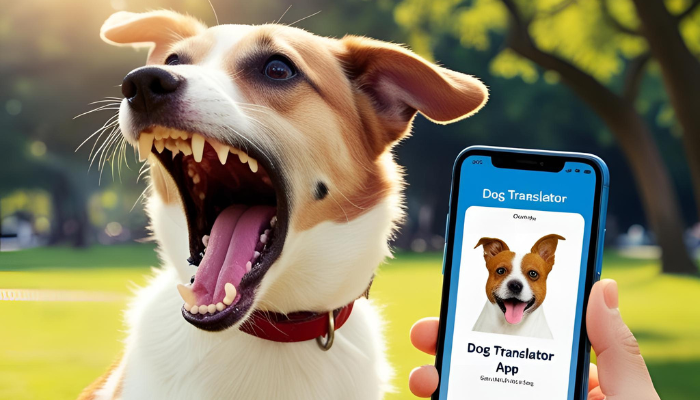Have you ever thought of “how do you say “hi” in dog language”? Different from humans, dogs rely on body movements, vocal sounds and smell to talk. A tail wag, a sniff, or even a playful bow can say so much more than just words. Recognizing those signals helps facilitate trust and deepen relations. Even if it’s through a dog translator or just watching their behavior, knowing how to approach a dog ensures they are well cared for. So let us go deeper into the world of dog communication.

Understanding Dog Communication
Dogs express themselves through body language, sounds, and scent. Understanding their signals helps build a stronger bond.
Dogs have their own ways in which they convey their emotions and intent. Greeting means:
- Body Language – Ushers in tail movements along with head up postures
- Sounds – Growls followed by barking alongside whining
- Scent Marking – Nose sniffing enables dogs to recognize each other.
Recognizing dog communication improves interactions and trust. Their signals reveal emotions, intent, and social cues.
How Dogs Say “Hi”?
Greeting does not always have to come in the form of words. Dogs have their own way of saying “hi” and it includes verbal and action forms. Here are some examples of dog greetings:
1. Wagging Tail
- A relaxed, wagging tail shows happiness.
- A high, stiff wag can indicate alertness or dominance.
- A low wag with a tucked tail means submission or nervousness.
2. Sniffing Each Other
- Dogs have a habit of sniffing each other’s faces and behinds.
- It is their method of understanding who the other dog is.
3. Play Bow
- A dog that has its backside up and lowers its front legs begs for some fun and games.
- It is also a friendly gesture where they are asking for a good time.
4. Soft Eye Contact
- Soft eye contact with little movement of eye lids is indicative of a friendly mood.
- If someone is too focused on a dog’s eyes, it can provoke the animal.
Recognizing how do you say “hi” in dog language helps build trust and connection. Understanding tail wags, sniffing, and play bows makes every interaction smoother.
How Do You Say “Hi” to a Dog Correctly?
Greeting a dog the right way builds trust and comfort. Letting them approach, using a calm voice, and reading body language are key. Understanding their signals ensures a positive interaction.
1. Let the Dog Approach You
- Avoid rushing towards a dog.
- Allow the dog to sniff and check you out first.
2. Use a Calm Voice
- Speak softly to avoid scaring the dog.
- Avoid loud or sudden noises.
3. Offer Your Hand for Sniffing
- Hold your hand out with fingers curled slightly.
- Let the dog decide to sniff or not.
4. Observe Body Language
- A relaxed posture means the dog is comfortable.
- When a dog looks anxious, give it some time to collect itself before approaching.
Knowing how do you say “hi” in dog language ensures safe and friendly interactions. Letting dogs approach, using a calm voice, and respecting their space builds trust. Understanding their signals strengthens your bond and makes greetings more comfortable.
How Humans and Dogs Greet Differently?
Humans and dogs greet each other in different ways. While we use handshakes and words, dogs rely on sniffing, wagging tails, and play bows. Understanding these differences strengthens our bond with them.
| Human Greeting | Dog Greeting | Meaning |
|---|---|---|
| Handshake | Sniffing nose or rear | Getting to know you |
| Hug | Leaning on you | Seeking affection |
| Smile | Wagging tail | Friendly approach |
| Verbal greeting | Soft whimper or bark | Excitement or acknowledgment |
| Waving hand | Play bow | Invitation to interact |
Learning how do you say “hi” in dog language improves interactions with dogs. Recognizing their unique greetings, like sniffing and play bows, fosters better communication. Respecting their signals builds trust and companionship.
How Do Dogs Greet Humans Differently?
Dogs greet humans in unique ways, using actions instead of words. Understanding their signals, like jumping or licking, strengthens your bond.
- Jumping – Dogs may exhibit excitement by jumping on humans.
- Licking – A dog licking your hands or face can simply mean affection.
- Bringing Toys – Dogs may greet you by bringing along their favorite toy.
- Leaning – Leaning on you signals trust and comfort.
Knowing how do you say “hi” in dog language helps you respond to their greetings correctly. Whether they jump, lick, or lean, each action carries meaning. Recognizing these cues builds a deeper connection with your dog.
Best Ways to Greet a Dog
Understanding how do you say “hi” in dog language helps create a friendly first impression. Using gentle movements, a warm tone, and letting them sniff you builds trust.
- Wagging your fingers gently as a tail wag.
- Speaking in a warm, friendly tone.
- Offering treats as a positive reinforcement.
- Lowering yourself to the dog’s level.
- Letting the dog sniff you first.
- Avoiding direct, prolonged eye contact.
- Using slow, deliberate movements.
- Petting gently under the chin rather than on the head.
- Playing with their favorite toy as an icebreaker.
- Mimicking a play bow by lowering your body slightly.
Recognizing a dog’s greeting style makes interactions smoother. Respecting their signals strengthens communication and companionship.
Common Mistakes When Greeting a Dog
Greeting a dog the wrong way can create fear or discomfort. Avoiding sudden movements, prolonged staring, and ignoring their signals helps build trust. Knowing the right approach ensures a positive interaction.
- Staring too long – Can make dogs feel threatened.
- Rushing towards them – Dogs prefer a slow, relaxed approach.
- Touching their head immediately – Some dogs don’t like being petted on the head first.
- Ignoring their signals – If a dog backs away, give it space.
- Using high-pitched noises – Some dogs can find this having a negative impact.
Understanding how do you say “hi” in dog language prevents common greeting mistakes. Giving dogs space, reading their body language, and using a calm approach strengthens your bond. Respecting their comfort makes every interaction smoother.
Conclusion
Grasping how do you say “hi” in dog language helps his bonds with dogs. Their greetings such as wagging their tails, sniffing and play bows communicate feelings. Speaking in a calm tone, allowing them personal space, and refraining from making abrupt actions enhances trust. Noticing these cues guarantees constructive engagements. Understanding how do you say hi in dog language makes reaching out and relating easier.
